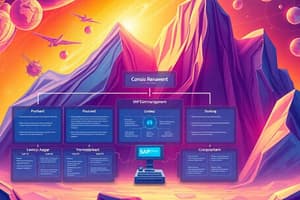Podcast
Questions and Answers
Which of the following components is NOT required in a notification?
Which of the following components is NOT required in a notification?
- Reported by
- Estimated completion time (correct)
- Technical object
- Description
What must happen before planning a maintenance order?
What must happen before planning a maintenance order?
- Order completion confirmation
- Customer billing initiation
- Notification must trigger order creation (correct)
- Mass editing of spare parts
Which function is NOT associated with maintenance order control functions?
Which function is NOT associated with maintenance order control functions?
- Time Confirmation (correct)
- Capacity requirements planning
- Printing work instruction papers
- Mass change or mass editing
What determines the planned costs for maintenance orders?
What determines the planned costs for maintenance orders?
Which of the following is NOT a step in order completion?
Which of the following is NOT a step in order completion?
What is a primary benefit of applying enterprise asset management?
What is a primary benefit of applying enterprise asset management?
Which unit within the SAP EAM organizational structure is responsible for maintaining a legal set of books?
Which unit within the SAP EAM organizational structure is responsible for maintaining a legal set of books?
What does the term 'Maintenance Plant' refer to in the SAP EAM structure?
What does the term 'Maintenance Plant' refer to in the SAP EAM structure?
Which of the following is NOT typically a part of the benefits of enterprise asset management?
Which of the following is NOT typically a part of the benefits of enterprise asset management?
In the context of EAM, what purpose does a 'Storage Location' serve?
In the context of EAM, what purpose does a 'Storage Location' serve?
What characterizes a 'Maintenance Planning Plant' in SAP EAM?
What characterizes a 'Maintenance Planning Plant' in SAP EAM?
Which of the following best describes 'Client' in the SAP EAM organizational structure?
Which of the following best describes 'Client' in the SAP EAM organizational structure?
What is an expected result of effective enterprise asset management?
What is an expected result of effective enterprise asset management?
What is the primary purpose of a functional location in SAP EAM?
What is the primary purpose of a functional location in SAP EAM?
What type of master data does BOM include in SAP EAM?
What type of master data does BOM include in SAP EAM?
Which of the following is NOT a benefit of functional location master data?
Which of the following is NOT a benefit of functional location master data?
In the context of equipment in SAP EAM, what does it primarily refer to?
In the context of equipment in SAP EAM, what does it primarily refer to?
Which process in SAP EAM gathers malfunctions and other requirements?
Which process in SAP EAM gathers malfunctions and other requirements?
What aspect does the equipment master data NOT specifically address?
What aspect does the equipment master data NOT specifically address?
What is the overarching advantage of having a Bill of Material (BOM) in EAM?
What is the overarching advantage of having a Bill of Material (BOM) in EAM?
How can functional locations assist in maintenance tasks?
How can functional locations assist in maintenance tasks?
Flashcards are hidden until you start studying
Study Notes
SAP Enterprise Asset Management (EAM)
- Focuses on managing, maintaining, inspecting, and repairing plant business assets throughout their life cycle
- Assets refer to the equipment, machinery, and facilities that an organization has
- Benefits include:
- Increased asset reliability: Proactive maintenance lessens unexpected breakdowns
- Improved efficiency: Reduced downtime, faster response time, and optimized resource utilization
- Cost-saving: Controlling maintenance expenses, minimizing unnecessary parts inventory, and extending asset lifespan
- Compliance and safety: Meeting regulatory compliance requirements and ensuring safety standards are upheld
EAM Organizational Structure
- Client: An independent environment within the system
- Company code: The smallest organizational unit where a legal set of books can be maintained
- Plant: The operating area of a branch within the company (e.g., manufacturing, distribution, purchasing, or maintenance facility)
- Storage location: An organizational unit differentiating various material stocks in a plant and required to store spare parts
- Maintenance plant: The plant where the company’s technical objects are installed, including locations, plant sections, and work centers.
- Maintenance planning plant: The plant where maintenance tasks are planned and prepared
EAM Master Data
- Functional location: Hierarchically organized structure representing the location (technical system, building, or part of it) where maintenance is performed
- Includes information about the functional location
- Can have different types of equipment
- Benefits:
- Structural depiction of the technical plant
- Planning and performing maintenance tasks
- Verification of maintenance tasks
- Data gathering for extended times
- Cost monitoring
- Behavioural analysis of individual areas under different conditions
- Equipment: Physical object for which maintenance tasks are planned and performed (e.g., pumps, personal computers, circulation fans, and engines)
- Can be placed in functional locations
- Benefits:
- Administration of individual objects and data
- Verification of maintenance tasks
- Object-oriented cost monitoring
- Data gathering and analysis for extended periods
- Bill of Material (BOM): Complete structured list of all components allocated to functional locations or equipment
- Types in EAM: Material BOMs, Equipment BOMs, and Function location BOMs
- Benefits:
- Structuring of objects
- Service parts planning in maintenance orders and maintenance task list
- Used in plant maintenance for similar objects
EAM Processes
- Notification: Gathers malfunctions and other maintenance requirements
- Highlights breakdowns that need quick action
- Used to record works already carried out
- Must include:
- Technical object
- Location data
- Breakdown
- Reported by
- Damage location
- Description
- Planning: Triggered by a notification, includes:
- Order creation
- Order planning: Steps to be performed, required parts, and specialized tooling
- Planned costs are calculated based on internal activity rates and external service costs
- Maintenance Order Control Functions: Vary depending on the order type
- Functions include:
- Mass change or mass editing
- Availability check for spare parts
- Capacity requirements planning
- Printing work instruction papers
- Functions include:
- Implementation and Completion:
- Planned and unplanned materials withdrawals (goods issues) are possible
- Completion steps:
- Time Confirmation
- Technical Completion Confirmation
- Technical Completion
- Customer billing is performed after successful technical completion
Studying That Suits You
Use AI to generate personalized quizzes and flashcards to suit your learning preferences.




